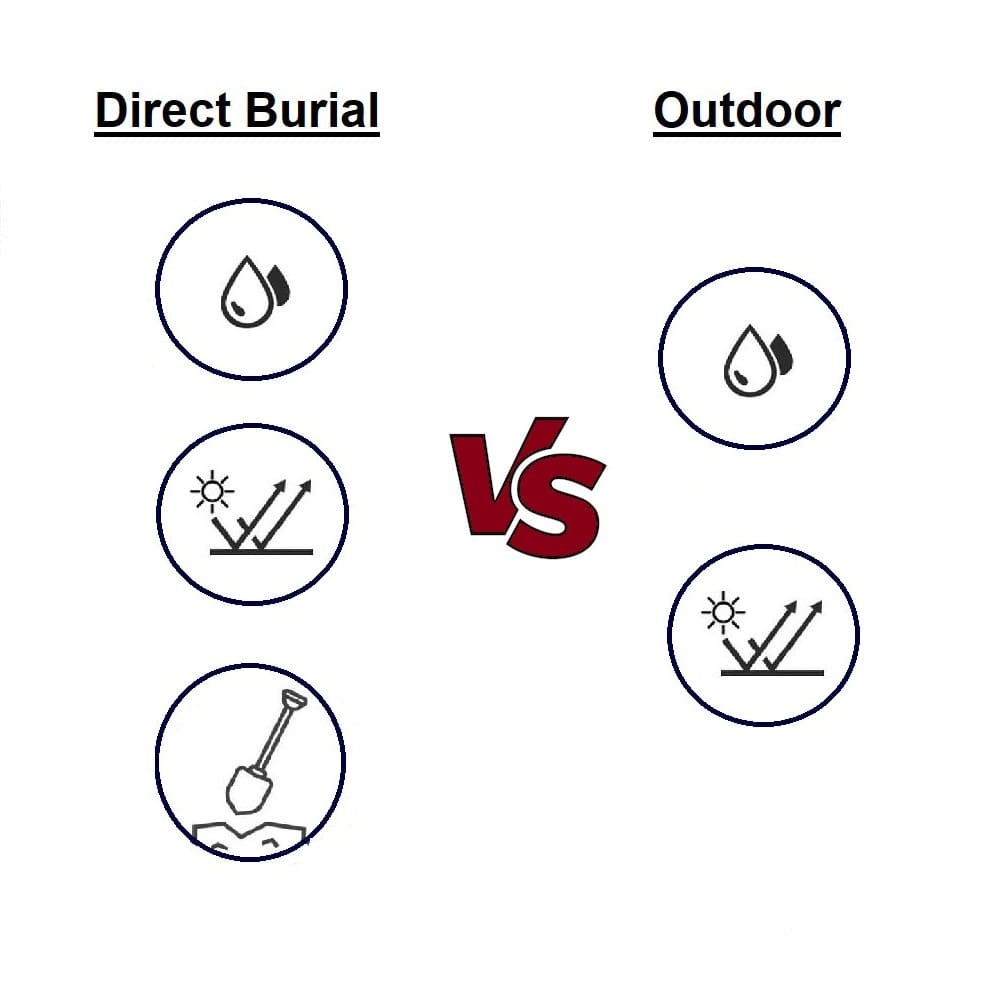Your Official Guide to Outdoor Ethernet Wire and Direct Burial Ethernet Cables
Are you considering using an indoor-rated Ethernet cable for outdoor applications?
Think again.
Doing so will damage your cables and waste money.
That is why you should use an outdoor Ethernet wire. However, you will need to know how to choose the best cable.
Throughout this post, we will dive into the differences between a direct burial and outdoor cables. Moreover, we will cover what you need to take into consideration before installing your cable and the process of installing your Ethernet wire.
What Are the Different Types of Outdoor/Direct Burial Cables?
Each category (CAT5e, CAT6, CAT6a, CAT7 and CAT8) of Ethernet cable can have an outdoor or direct burial version. Moreover, as with indoor cables, outdoor wires can be shielded or unshielded.
While these cables may appear the same, they have differences that determine whether they are worth using for your applications. Keep reading to learn the different types of outdoor Ethernet cables and the materials used to create them.
Outdoor-Rated
These cable’s UV- and heat-resistant jackets differentiate them from other outdoor Ethernet cables. Because of this design choice, you should use these cables outside, as opposed to burying them.
If you need an Ethernet cable in an outdoor setting, you will also need to consider temperature changes, which we will cover later in this guide. You can purchase these cables with jackets made of PVC or Polyethylene (PE) material to give you a quick background.
Both materials have distinct advantages; therefore, you will need to decide what you will need before purchasing.
You can bury these cables if needed. However, ensure you use a conduit when doing so.
Direct Burial
A direct burial-rated outdoor Ethernet cable allows you to bury these types of cables without adding conduits. Moreover, these cables also can have a PVC jacket like their outdoor counterparts. But, they also have a different setup on the inside.
When choosing a material for your direct burial cable, you have different options that include the following.
Gel Filled
A gel the manufacturer injects into the cable that fills all crevices throughout the cable. The water-blocking gel protects the wires from water and helps prevent damage to the cable’s conductors.
SAP-Treated Yarn
A type of yarn or fiber that manufacturers treat with a Super Absorbent Polymer (SAP). If anything were to penetrate the cable, these fibers would absorb any moisture and block water from touching the cable’s innards.
Waterproof Tape
A type of tape that the manufacturers wrapped around the cable. It adds a layer of moisture and water resistance in a scenario where you may find your wire damaged.
What Are the Differences Between an Outdoor Ethernet Wire and a Direct Burial?
First off, the main difference between a direct burial and an outdoor Ethernet wire is that one was designed to be buried while the other is not. However, there are several other differences that you should consider before making a purchase.
Some of the other differences between a direct burial and outdoor Ethernet cables include:
- Materials: outdoor cables block sunlight while direct burial prevents moisture
- Applications: use a direct burial Ethernet cable for providing internet to a shed or outdoor cables for powering security cameras
- Environments: a direct burial Ethernet wire thrives in humid climates due to its waterproof materials
What To Consider Before Outdoor Ethernet Wire Installation
Before installing your Ethernet wires outside, you will need to take precautions and gather information first. Otherwise, you may run into having to perform more maintenance than needed later on.
How You Will Run Your Cable
Before doing anything with your Ethernet cable installation, you will need to plan your cable placement. First off, you will want to consider any future landscaping that you have planned for your property. That way, you prevent excavating your wires in the future.
Choose the Correct Cable
As mentioned above, both direct burial and outdoor cables serve different purposes and have advantages in different climates. Consider the environment you are in, the applications that you will have for these cables, and whether you will need to remove the cable in the future.
Temperatures
Since you are burying your cables outdoors, you will need to pay more attention to insulating your cables. Otherwise, you will run the risk of damaging your sensitive Ethernet wires with the elements.
Moreover, when you are shopping, keep in mind that every cable has a temperature rating.
First off, if you live in a climate where the temperature has the potential to fall -4 Fahrenheit (-20 Celsius) and -40 Fahrenheit (-40 Celsius), you will need a more insulated cable. We recommend getting your hands on cable with an outdoor-rated PE jacket.
Otherwise, if you can guarantee temperatures will remain above -4 Fahrenheit, you may find it safe to go with a Polyvinyl Chloride (PVC) jacket.
How To Install an Outdoor Ethernet Cable
When installing your cable, you should ensure you do not damage other underground installations. For instance, keep your Ethernet cables at least 8 inches (20 centimeters) away from power lines.
Afterward, you will need to plan how deep you should bury your cable. We recommend a depth of at least two feet. Because if you do not bury your cable deep enough, it may suffer the risk of becoming severed someday.
Once you plan your layout, you will need to get your hands on a portable trenching machine to ensure you do your job right.
What happens if lightning strikes ethernet cables
When Lightning strikes your outdoor cables the power surge may travel to the house and damage all your equipment. Burying the cables will not lessen that risk. We always recommend installing Surge Protector for any outdoor Ethernet installations to prevent damage to your indoor equipment.
Important: Nothing will protect against direct hit of lightning. Installing a Surge protector will help against induced current traveling to the house.
What Else Should You Know About Ethernet Cables?
Throughout this guide, you have learned the differences between an outdoor Ethernet wire and a direct burial. Moreover, you have learned how to prepare for your cable installation and the process itself.
The next step is to shop for your outdoor or direct cable.
SatMaximum has various outdoor and direct burial cables in stock. However, if you need a cable that extends up to 200 feet, we recommend looking into our SFTP Outdoor/Direct Burial CAT7 cable.















































